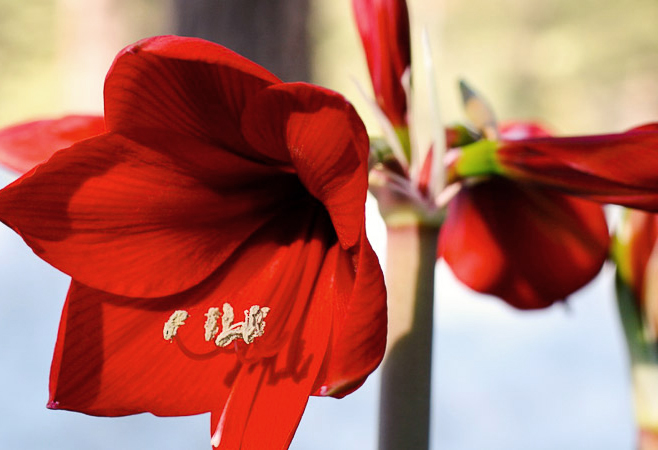
AMARYLLIS CARE

Large bell-shaped or lily-like flowers of the amaryllis (Hippeastrum species) and its hybrids make excellent garden and potted plants and come in a wide range of colors: red, white, pink, orange, salmon or bicolor, they typically have 2-6 flowers per stalk. Most bulbs are Dutch or South African grown hybrids that will flower without special treatment when first purchased. Planting and care is the same for amaryllis bulbs, whether repotting an old bulb or a new one just purchased. With old bulbs, cut off the old dried leaves before replanting.
Soil Mix and Container: Amaryllis can be potted or repotted anytime after the plants have gone dormant or rest period (fall or winter). Late November is an ideal time. Plant the bulb in a container that is 1” to 2” larger in diameter than the bulb base. Potted bulbs thrive under conditions where they are slightly root bound. Use either clay or plastic containers that have drainage holes in the bottom. Plant amaryllis with 1/3 to 1/2 of the bulb above the growing medium surface. This keeps the bulb’s nose dry and helps reduce red blotch infection, a fungal disease. Use well drained, sterilized potting medium with a soil pH between 6.0 and 6.5. A mixture of equal parts peat and perlite is excellent.
Light and Temperature: Sun-loving amaryllis grows best indoors in a well-lighted area that receives at least 4 hours of direct sunlight daily. Southern window exposure is best, followed by east or west facing window. Amaryllis prefers warm temperatures (70 to 75 °F) for best growth until the roots form and the leaves and flower stalk begins to grow. Once the plant flowers, cooler temperatures (65 °F) will prolong the life of the flower.
Water Immediately after planting, thoroughly water the bulb. Keep the bulb in a slightly moist soil condition until flowering. When flowering starts, increase the frequency of watering. It is best to water your plant when the soil surface feels dry to the touch. Watering once per week is usually adequate.
Fertilizer: Fertilizing an amaryllis bulb with no leaves can kill the roots. After the plant begins to grow fertilization is essential. Fertilize twice a month with a soluble fertilizer recommended for potted plants at full strength and frequency.
Care After Flowering The secret of successful growing is to keep the plants actively growing after they finish blooming. Remove the blossoms as soon as they fade to prevent seed formation by cutting the stem off just above the bulb. Place in a sunny window. During the next several months growth is active and should be encouraged for future bulb development. Keep the soil slightly moist and fertilize with a balanced houseplant fertilizer at regular intervals. You can continue to grow your amaryllis indoors all year or outdoors as soon as the danger of frost has passed in the spring.
Reflowering: Several things are needed to encourage amaryllis to flower again. Continue growing your bulb as you would other houseplants, providing proper light and water to keep the leaves healthy and growing. It may also be set out on the patio or deck in the spring after all danger of frost has passed. Put in full shade for 2 weeks. Gradually give more sun until it receives a good ½ day of sun.
Stop watering the plant around Labor Day. Set the pot in a cool, dark spot for the next 8-10 weeks. The leaves will yellow and wither. When you see the top of the flower bud beginning to emerge, put the pot in a sunny area and start watering it again. Remove all dry foliage. As the flower stalk begins to lengthen, rotate the plant every few days to prevent the stem from leaning towards the light.
PROBLEMS Main disease problems are mosaic virus, bulb rot and red blotch. Plants infected with mosaic virus have light yellow streaking of the leaves and reduced growth and flowering over the years. Nothing can eliminate mosaic from an infected plant. Bulb and root rot typically occur when the soil is kept too wet or by using bruised bulbs. When bulb or root rot problems are suspected, discard diseased bulbs and replace soil. The fungal disease “red blotch” causes reddish brown spots on the bulb, leaves and/or scape. It can spread rapidly within a bulb and from bulb to bulb. Insects and other pests that can become a problem include scale, mites, thrips, bulb maggots and mealy bugs.
Exerpted from Understanding and Producing Amaryllis, HL 63.
Home Forcing of Potted Amaryllis,North CarolinaStateUniversity, Leaflet 8529, 1994.

